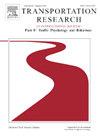Effects of connected vehicle (CV) technology on improving driver behavior in the presence of connected and automated vehicle (CAV) platoons
IF 3.5
2区 工程技术
Q1 PSYCHOLOGY, APPLIED
Transportation Research Part F-Traffic Psychology and Behaviour
Pub Date : 2025-02-01
DOI:10.1016/j.trf.2025.01.046
引用次数: 0
Abstract
The combination of automated vehicle technology and vehicle-to-vehicle (V2V) communication leads to the advantage of platoon formation with short inter-vehicular distance. While connected and automated vehicle (CAV) platoons are expected to improve roadway capacity and lower fuel consumption, they might cause some challenges for non-platooning vehicles. This study aims to investigate the hypotheses that providing connected vehicle (CV) warning messages regarding the presence of CAV platoons can improve driver behavior and safety. A driving simulator experiment, featuring four configurations (merging without warning, merging with warning, diverging without warning, and diverging with warning) was designed and tested on 70 drivers. In the ‘no warning’ configurations, drivers encountered CAV platoons without any warning, whereas an audio warning was provided in the ‘warning’ configurations. The findings revealed that providing the warning led to a 17 % increase in merging behind the platoons, whereas more than 90 % of the drivers diverged behind the platoons irrespective of the warning conditions. Six performance measures including mean speed, maximum deceleration, speed standard deviation (SD), acceleration SD, minimum time-to-collision (mTTC), and merging/diverging time were modeled using generalized linear models. The results indicated lower merging and diverging time when provided with warning. Additionally, safety improvement during merging was observed in terms of about 20 % higher mTTC. Safety improvement during diverging was reflected through lower maximum deceleration, speed SD, acceleration SD, and around 5 % higher mTTC. Moreover, female and younger drivers behaved more safely in the ‘warning’ configurations. These results provide insights for planning authorities and auto manufacturers on the usefulness of CV warnings about CAV platoons in improving driver behavior and traffic safety.
求助全文
约1分钟内获得全文
求助全文
来源期刊
CiteScore
7.60
自引率
14.60%
发文量
239
审稿时长
71 days
期刊介绍:
Transportation Research Part F: Traffic Psychology and Behaviour focuses on the behavioural and psychological aspects of traffic and transport. The aim of the journal is to enhance theory development, improve the quality of empirical studies and to stimulate the application of research findings in practice. TRF provides a focus and a means of communication for the considerable amount of research activities that are now being carried out in this field. The journal provides a forum for transportation researchers, psychologists, ergonomists, engineers and policy-makers with an interest in traffic and transport psychology.

 求助内容:
求助内容: 应助结果提醒方式:
应助结果提醒方式:


